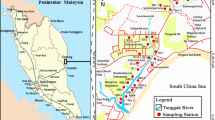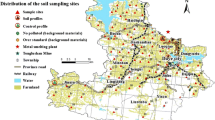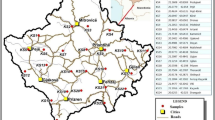Abstract
Heavy metals in the surface soils from lands of six different use types in one of the world’s most densely populated regions, which is also a major global manufacturing base, were analyzed to assess the impact of urbanization and industrialization on soil pollution. A total of 227 surface soil samples were collected and analyzed for major heavy metals (As, Cd, Co, Cr, Cu, Fe, Hg, Mn, Ni, Pb, and Zn) by using microwave-assisted acid digestion and inductively coupled plasma–mass spectrometry (ICP-MS). Multivariate analysis combined with enrichment factors showed that surface soils from the region (>7.2 × 104 km2) had mean Cd, Cu, Zn, and As concentrations that were over two times higher than the background values, with Cd, Cu, and Zn clearly contributed by anthropogenic sources. Soil pollution by Pb was more widespread than the other heavy metals, which was contributed mostly by anthropogenic sources. The results also indicate that Mn, Co, Fe, Cr, and Ni in the surface soils were primarily derived from lithogenic sources, while Hg and As contents in the surface soils were controlled by both natural and anthropogenic sources. The pollution level and potential ecological risk of the surface soils both decreased in the order of: urban areas > waste disposal/treatment sites ∼ industrial areas > agricultural lands ∼ forest lands > water source protection areas. These results indicate the significant need for the development of pollution prevention and reduction strategies to reduce heavy metal pollution for regions undergoing fast industrialization and urbanization.




Similar content being viewed by others
References
Alloway BJ (1995) Heavy metals in soils, 2nd ed. Blackie Academic and Professional, London
Cheng H, Hu Y (2010a) Lead (Pb) isotopic fingerprinting and its applications in lead pollution studies in China: a review. Environ Pollut 158(5):1134–1146
Cheng H, Hu Y (2010b) China needs to control mercury emissions from Municipal Solid Waste (MSW) incineration. Environ Sci Technol 44(21):7994–7995
Cheng H, Hu Y (2012) Mercury in municipal solid waste in China and its control: a review. Environ Sci Technol 46(2):593–605
Cheng J, Shi Z, Zhu Y (2007) Assessment and mapping of environmental quality in agricultural soils of Zhejiang Province, China. Huangjin Kexue 19(1):50–54
Cloquet C, Carignan J, Libourel G, Sterckeman T, Perdrix E (2006) Tracing source pollution in soils using cadmium and lead isotopes. Environ Sci Technol 40(8):2525–2530
Hakanson L (1980) An ecological risk index for aquatic pollution control. A sedimentological approach. Water Res 14(8):975–1001
Hu Y, Cheng H (2012) Mercury risk from fluorescent lamps in China: current status and future perspective. Environ Int 44:141–150
Hu Y, Cheng H (2013) Application of stochastic models in identification and apportionment of heavy metal pollution sources in the surface soils of a large-scale region. Environ Sci Technol. doi:10.1021/es304310k
Kaiser HF (1960) The application of electronic computers to factor analysis. Educ Psychol Meas 20:141–151
Kober B, Wessels M, Bollhöfer A, Mangini A (1999) Pb isotopes in sediments of Lake Constance, Central Europe constrain the heavy metal pathways and the pollution history of the catchment, the lake and the regional atmosphere. Geochim Cosmochim Ac 63(9):1293–1303
Kubosova K, Komprda J, Jarkovsky J, Sanka M, Hajek O, Dusek L, Holoubek I, Klanova J (2009) Spatially resolved distribution models of POP concentrations in soil: a stochastic approach using regression trees. Environ Sci Technol 43(24):9230–9236
Li X, Shen Z, Wai OWH, Li YS (2001) Chemical forms of Pb, Zn and Cu in the sediment profiles of the Pearl River Estuary. Mar Pollut Bull 42(3):215–223
Li X, Wai OWH, Li YS, Coles BJ, Ramsey MH, Thornton I (2000) Heavy metal distribution in sediment profiles of the Pearl River estuary, South China. Appl Geochem 15(5):567–581
Liu Q, Diamond ML, Gingrich SE, Ondov JM, Maciejczyk P, Stern GA (2003) Accumulation of metals, trace elements and semi-volatile organic compounds on exterior window surfaces in Baltimore. Environ Pollut 122(1):51–61
Mireles F, Davila JI, Pinedo JL, Reyes E, Speakman RJ, Glascock MD (2012) Assessing urban soil pollution in the cities of Zacatecas and Guadalupe, Mexico by instrumental neutron activation analysis. Microchem J 103:158–164
Nagajyoti PC, Lee KD, Sreekanth TVM (2010) Heavy metals, occurrence and toxicity for plants: a review. Environ Chem Lett 8(3):199–216
Nowak B (1998) Contents and relationship of elements in human hair for a non-industrialised population in Poland. Sci Total Environ 209(1):59–68
SEPA (State Environmental Protection Administration) (1995) Environmental quality standard for soils (GB 15618–1995). SEPA, Beijing
Sutherland RA (2000) Bed sediment-associated trace metals in an urban stream, Oahu, Hawaii. Environ Geol 39(6):611–627
USEPA (1996) EPA Method 3052: Microwave assisted acid digestion of siliceous and organically based matrices. Test methods for evaluating solid waste. USEPA, Washington, DC
Vega FA, Matias JM, Andrade ML, Reigosa MJ, Covelo EF (2009) Classification and regression trees (CARTs) for modelling the sorption and retention of heavy metals by soil. J Hazard Mater 167(1–3):615–624
Wei B, Yang L (2010) A review of heavy metal contaminations in urban soils, urban road dusts and agricultural soils from China. Microchem J 94(2):99–107
Xia B, Wu D (2011) Spatial variation and vertical distribution of soil Cr in Guangdong province based on geo-statistics. Hubei Nongye Kexue 50(21):4368–4370
Xu Z, Ni S, Tuo X, Zhang C (2008) Calculation of heavy metals' toxicity coefficient in the evaluation of potential ecological risk index. Huangjin Kexue yu Jishu 31(2):112–115
Yang G, Luo W, Zhang T, Wan H, Gao Y (2007) The distribution of Ni contents in agricultural soils in the Pearl River Delta, China. Shengtai Huanjing 16(3):818–821
Yaylalı-Abanuz G (2011) Heavy metal contamination of surface soil around Gebze industrial area, Turkey. Microchem J 99(1):82–92
Zhang X, Lin F, Jiang Y, Wang K, Wong MTF (2008) Assessing soil Cu content and anthropogenic influences using decision tree analysis. Environ Pollut 156(3):1260–1267
Acknowledgments
The authors thank Zaicheng He, Yanli Wei, Liangying Liu, Haiyan Hu, and Baozhong Zhang for help with field sampling. This work was supported in parts by the Natural Science Foundation of China (grant nos. 41202251, 41121063, and 41073079) and the Chinese Academy of Sciences (Y234081001 and “Interdisciplinary Collaboration Team” program). This is contribution No. IS-1648 from GIGCAS.
Author information
Authors and Affiliations
Corresponding author
Additional information
Responsible editor: Zhihong Xu
Electronic supplementary material
Below is the link to the electronic supplementary material.
ESM 1
(DOC 213 kb)
Rights and permissions
About this article
Cite this article
Hu, Y., Liu, X., Bai, J. et al. Assessing heavy metal pollution in the surface soils of a region that had undergone three decades of intense industrialization and urbanization. Environ Sci Pollut Res 20, 6150–6159 (2013). https://doi.org/10.1007/s11356-013-1668-z
Received:
Accepted:
Published:
Issue Date:
DOI: https://doi.org/10.1007/s11356-013-1668-z




